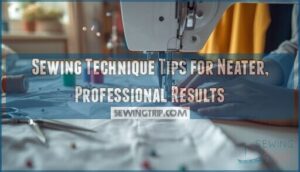This site is supported by our readers. We may earn a commission, at no cost to you, if you purchase through links.

Wet the thread tip slightly or run it through beeswax to stiffen it. Match your needle size to thread weight; forcing thick thread through tiny eyes creates frustration.
Good lighting is your secret weapon—position a white paper behind the needle eye for contrast. Hold the needle steady and guide thread from front to back in one smooth motion.
These fundamental sewing needle threading tips transform a tedious task into effortless precision. But there’s more to master than just getting thread through the eye, including understanding the importance of good lighting and the right needle size.
Table Of Contents
Key Takeaways
- Match your needle size to thread thickness – You’ll avoid frustration by choosing needle eyes that are at least twice your thread’s width, ensuring smooth passage without forcing thick threads through tiny openings.
- Cut thread at sharp angles and prepare properly – You’ll thread faster when you cut clean 45-degree angles with quality scissors and consider waxing the thread to reduce tangles and improve stiffness.
- Use good lighting and contrast techniques – You’ll see the needle eye clearly by positioning white paper behind it for contrast and ensuring adequate lighting in your workspace.
- Choose the right needle type for your fabric – You’ll get better results by selecting sharp-point needles for woven fabrics and blunt tips for knits, preventing snags while maintaining threading ease.
Select Right Needle
You’ll find threading success starts with picking the right needle for your project.
Start every sewing project right by choosing a needle that matches your thread for effortless threading and smooth stitching.
Choose a needle with an eye at least twice as wide as your thread – this simple match prevents frustration and makes threading effortless every time.
This simple technique ensures that you have a smooth threading experience.
Needle Size Importance
Your needle’s eye size directly impacts threading success and sewing precision. When the needle eye size matches your thread diameter, you’ll thread faster and avoid frustration.
Choose needle sizes that accommodate your thread while maintaining fabric compatibility. Smaller needles work best with fine threads, while heavier threads need larger needle eyes.
This needle material and sizing combination guarantees smooth thread management and superior sewing needle selection for every project. For best results, consider consulting a thread guide to determine the best thread and needle combination for your specific sewing needs.
Needle Type Selection
Your needle’s design determines threading success.
Sharp points pierce fabric easily, while blunt tips work best for knits.
Consider these essentials:
- Sharp Points – Perfect for woven fabrics and precise stitching work
- Blunt Tips – Ideal for knit materials to prevent snags and runs
- Eye Size – Larger eyes accommodate thicker threads without forcing
Match your needle’s flexibility and materials to your project’s demands for effortless threading.
Understanding the right sewing needle types is vital for achieving professional results.
Thread Compatibility
Perfect thread matching transforms frustrating threading sessions into smooth sailing.
Perfect thread pairing turns threading battles into effortless victories.
You’ll want your needle eye at least twice your thread’s width – forcing thick threads through tiny eyes creates fraying nightmares.
Match thread types to your fabric: cotton threads for cotton fabrics, polyester for synthetics.
Consider fiber types and yarn weights carefully.
Color selection matters too – darker threads hide better when exact matches aren’t available, making color selection a crucial aspect.
Choose Thread Thickness
You’ll find the right thread weight makes threading a breeze rather than a battle.
Match your thread thickness to your needle size – thick threads need large needle eyes, while fine threads work with smaller openings.
Thread Size Measurement
You’ll want to match your thread size to your needle eye size for smooth threading.
Thread Diameter varies substantially – use Size Charts or Measurement Tools like Thread Gauges to identify your thread’s thickness. A Micrometer Calibration helps with precision measurements.
Remember, your needle eye size should be at least twice your thread’s diameter for easy passage. Understanding the correct thread weight systems is vital for selecting the right thread for your project, considering the thread size and needle eye size for a smooth experience, and knowing the thread weight is also crucial.
Thread Material Selection
Matching thread materials with fabric types creates the foundation for successful projects.
Natural fibers work best with cotton or linen, while synthetic threads pair perfectly with polyester fabrics.
- Cotton thread – Ideal for natural fabrics, provides excellent strength and color retention
- Polyester thread – Perfect for synthetic materials, offers superior stretch and durability
- Silk thread – Premium choice for delicate fabrics, delivers smooth sewing machine performance
Understanding the right thread weight options is essential for achieving professional results in sewing projects.
Thread Color Choice
When you’re choosing thread colors, darker shades work better than lighter ones when you can’t find an exact fabric match.
Color matching techniques become easier with fabric contrast in mind – thread that’s slightly darker than your material disappears into seams better than lighter thread.
Consider dye selection carefully since thread colors can shift under different lighting. Good shade coordination means your thread twist won’t stand out awkwardly against the fabric’s natural hue, ensuring a more seamless integration with fabric contrast.
Use Needle Threader
If you’ve been struggling with threading needles by hand, a needle threader can be your best friend.
These simple tools make the process quick and painless, whether you choose a basic wire loop threader or an automatic device built into your sewing machine.
Manual Threading Method
Manual needle threading starts with proper Thread Alignment and steady Finger Guidance.
Hold your needle against a white background, then bring the thread to the needle eye rather than forcing it through.
Use the Loop Technique: create a small loop with your thread, pinch it flat, then guide your needle through.
These manual threading techniques work better than chasing the thread around with shaky hands, utilizing Finger Guidance for success.
Automatic Threading Device
Modern sewing machines frequently feature automatic needle threader devices that revolutionize your threading experience.
These sophisticated systems use electronic sensors and precise motors to guide thread through needle eyes effortlessly. Simply position your thread, activate the automatic modes, and watch as the device completes threading in seconds.
Regular device maintenance guarantees maximal threading speed and motor efficiency for consistent performance.
The use of an automatic threader can substantially improve sewing efficiency and accuracy.
Threader Handling Tips
Delicate wire loops demand gentle handling to prevent breakage.
Always grip the threader’s handle, not the wire itself, when guiding it through needle eyes.
Store your needle threader tool in a protective case to avoid damage.
The wire loop should slide smoothly through the eye without forcing—if resistance occurs, check your needle alignment before proceeding with threading techniques.
Prepare Thread Properly
Getting your thread ready can make or break your sewing project.
You’ll want to cut it at a sharp angle, consider waxing it for strength, and store it properly to prevent tangles.
Cutting Thread Correctly
Cut your thread at a sharp 45-degree angle using quality scissors. This angled cut creates a pointed tip that slides through needle eyes effortlessly.
Sharp scissors prevent fraying and guarantee clean cuts every time. Dull blades create ragged ends that won’t cooperate with threading.
Keep dedicated sewing scissors nearby – they’re your thread cutting allies for professional results.
Waxing Thread Benefits
Waxing thread creates a game-changing advantage for your sewing projects.
The coating enhances thread durability while providing essential fiber protection against friction damage.
You’ll notice significant tangle reduction and improved threading ease when working with your thread sewing machine.
Different sewing thread types benefit from wax application, making needle threading tips more effective.
This simple technique transforms ordinary thread cutting preparation into professional-quality results for seamless sewing needle threading.
The proper application of wax involves understanding thread waxing products, which are often available through online sewing thread suppliers.
The use of waxing thread results in improved threading ease and is a simple yet effective method to enhance your sewing experience.
By applying wax to your thread, you can achieve seamless sewing and make your projects more enjoyable and efficient.
Thread Storage Methods
Store your thread properly to prevent deterioration and threading problems.
Keep Thread Spools in Storage Cases or Thread Boxes to protect from dust and moisture.
Organize different Fiber Organization systems by color or project using Yarn Wrapping techniques.
Proper thread storage and sewing thread management maintain thread quality, making thread cutting and sewing thread organization easier when you need specific sewing thread types.
Effective sewing embroidery thread storage solutions, such as using a thread storage system, can help keep your workspace organized and clutter-free, which is important for proper thread storage and sewing thread management, and ultimately leads to better thread quality.
Troubleshoot Threading
Threading problems happen to everyone, even experienced sewers. You’ll find that most issues stem from poor lighting, frayed thread ends, or mismatched needle and thread sizes.
Common Threading Issues
Most threading problems stem from three main culprits that’ll drive you crazy if you don’t catch them early.
Threading sewing needles becomes a nightmare when frayed threads meet damaged eyes, creating threading frustration that tests your patience.
Thread knot formation and tangling prevention start with recognizing these warning signs.
- Frayed Threads – Cut clean angles with sharp scissors to prevent threading difficulty and thread breakage
- Eye Damage – Replace bent or damaged needles immediately to avoid threading frustration
- Thread Quality – Use fresh, quality thread for better needle threading tips and tangle prevention
Thread Tension Adjustment
When sewing machine threading becomes stubborn, proper thread tension holds the key to smooth operation.
Adjust your upper thread tension dial gradually—start with the middle setting and test on fabric scraps. Bobbin tension also affects threading ease, especially with delicate fabrics that stretch.
Understanding proper thread tension is essential for achieving perfect stitches.
| Tension Issue | Solution |
|---|---|
| Thread breaks during threading | Reduce upper tension, check needle size |
| Loops under fabric | Increase upper tension slightly |
| Puckered seams | Lower tension for fabric stretch |
| Skipped stitches | Balance thread tension with stitch quality |
Perfect tension control creates threading ease while maintaining stitch quality across different fabric types.
Frequently Asked Questions (FAQs)
How do you thread embroidery needles with multiple strands?
Cut your embroidery floss to about 18 inches, then separate the strands you need.
Thread them together through your needle’s eye using a needle threader or the pinch method for easier control.
What causes thread to keep breaking while threading?
Thread breaks while threading when you’re forcing it through a needle eye that’s too small, using old or poor-quality thread, or pulling too hard.
Sharp scissors create clean cuts that prevent fraying and breaking.
Can you thread needles in low light conditions?
You’ll struggle in darkness, but it’s doable! Use a bright phone flashlight or desk lamp. Hold the needle against white paper for contrast. Your fingers will thank you.
How do you thread curved or specialty needles?
Position curved needles with their curve facing up for stability.
Use needle-nose pliers to grip the shaft while threading.
Threading from the outer curve side works best since it follows the natural bend.
Whats the best threading method for arthritic hands?
Like threading a needle with boxing gloves on, arthritis can make this task challenging, but you’ve got options.
Try self-threading needles with side slots or needle threaders that eliminate manual dexterity needs completely.
Conclusion
Practice makes perfect when mastering these sewing needle threading tips.
You’ll find threading becomes second nature once you’ve applied the right needle size, proper thread preparation, and good lighting techniques.
Remember to keep your workspace organized and your tools clean for consistent results.
Don’t get discouraged if it takes a few tries—even experienced sewers occasionally miss the mark.
With these fundamentals in your toolkit, you’re ready to tackle any project with confidence and precision.














